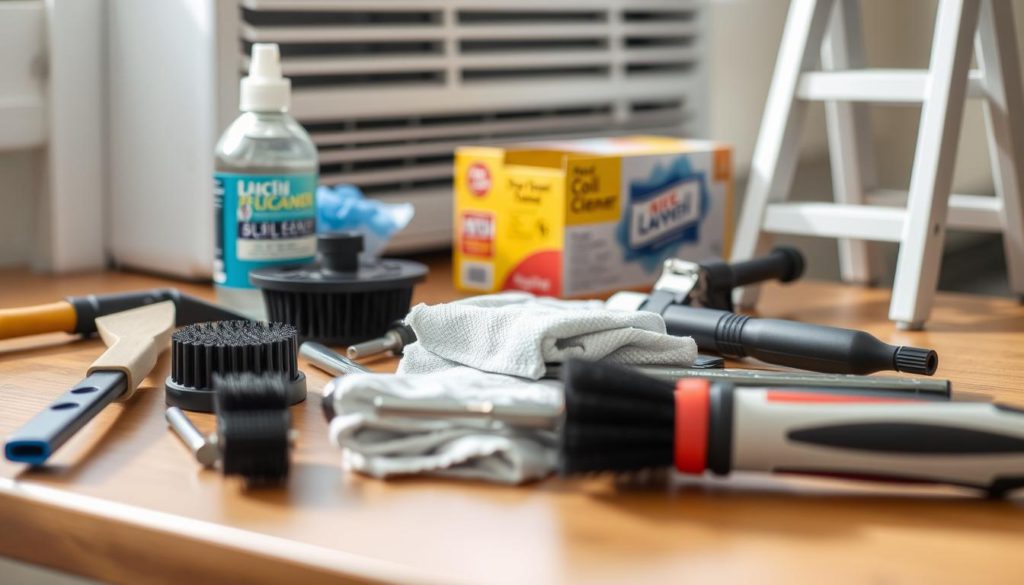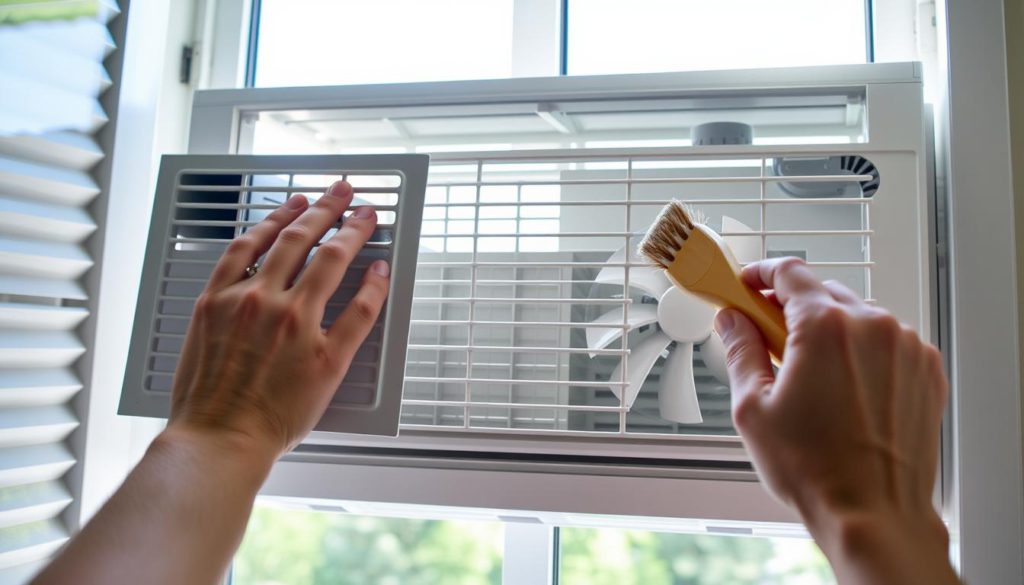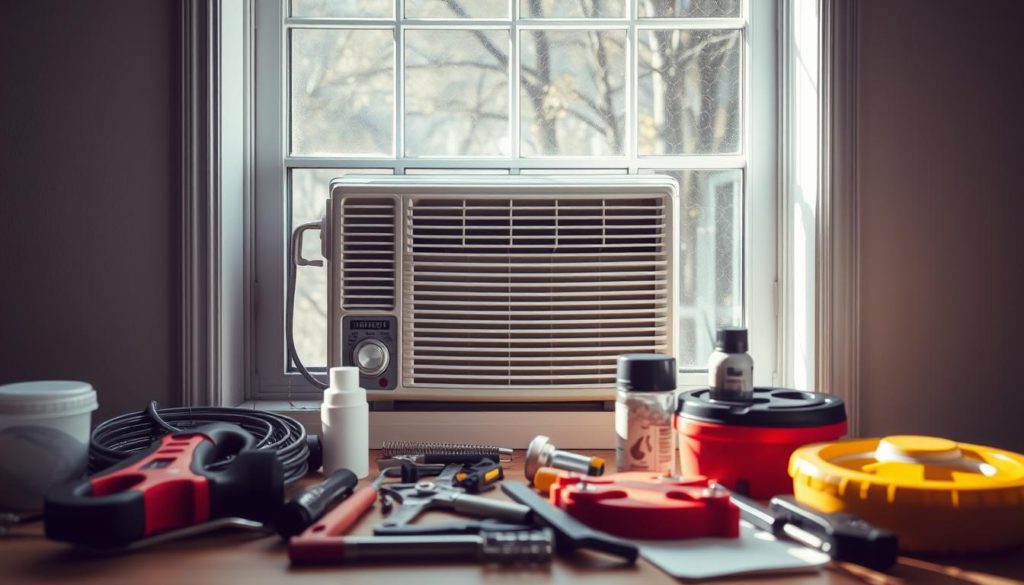What if your window air conditioner isn’t just cooling your room—it’s secretly costing you money and compromising your comfort? As temperatures rise, many homeowners overlook a critical truth: neglected units work harder, consume more energy, and spread dust or mold. A well-maintained system doesn’t just chill your space—it protects your health and wallet.
Dirt and debris build up over time, clogging filters and coils. This forces the unit to strain, reducing airflow and efficiency. Left unchecked, moisture can lead to mold growth, affecting air quality. Inspecting components like fins and drainage channels ensures smooth operation.
Regular maintenance extends your conditioner’s lifespan and prevents breakdowns during peak heat. Simple steps—like vacuuming dust or using a soft brush on coils—make a difference. Always review safety guidelines before handling electrical parts.
Key Takeaways
- Cleaning improves cooling efficiency and reduces energy costs.
- Focus on filters, coils, and fins to prevent airflow blockages.
- Check for mold in drainage areas to maintain healthy air quality.
- Follow manufacturer instructions to avoid damaging delicate parts.
- Proper care now means fewer repairs when summer hits hardest.
Preparation and Safety Tips

Proper preparation transforms routine upkeep into a safeguard for your cooling system. Gather supplies first to avoid mid-task interruptions—this ensures smooth progress and protects delicate components.
Essential Tools for Effective Maintenance
Assemble these items before starting:
| Tool | Purpose |
|---|---|
| Soft-bristle brush | Removes dust from fins without bending them |
| Handheld vacuum | Clears loose debris from filters and vents |
| Fin comb | Straightens bent aluminum fins for airflow |
| Mild detergent | Cleans filters without corrosive damage |
Smart Practices Before Cleaning
Always unplug the unit. Check the power cord for chew marks or fraying—rodent damage during storage is common. Review your manual for coil-cleaning specifics; some models require specialized approaches.
Mix warm water with dish soap for filter washing. Harsh chemicals degrade mesh materials over time. Wear gloves when handling drainage areas to avoid contact with mold or standing water.
These steps take 10 minutes but prevent hours of frustration. Well-prepared maintenance boosts airflow efficiency by up to 15%, according to HVAC professionals. Your system will thank you when temperatures soar.
Step-by-Step Guide: How to Clean Your Window AC Unit Before Summer

A thorough cleaning routine revives your cooling system’s performance while preventing hidden issues. Focus on three critical areas: surface debris removal, component care, and drainage checks. Work methodically to avoid missing spots that impact airflow or energy use.
Vacuuming, Dusting, and Brush Techniques
Start by unplugging the unit. Use a vacuum’s soft brush attachment to clear loose dirt from vents and exterior surfaces. Gently brush aluminum fins upward—this prevents bending while dislodging trapped particles. For stubborn buildup, a fin comb straightens bent fins and improves airflow.
Cleaning Coils, Fins, and Filters
Spray foam-based degreaser on evaporator coils. Let it sit for 5 minutes before wiping with microfiber cloths. Remove filters and soak them in warm water mixed with mild dish soap. Rinse thoroughly and air-dry completely before reinstalling.
Inspecting for Mold and Debris in Drainage
Check the drain pan and channels for dark spots or musty odors. Apply mold remover with a toothbrush if needed. Clear clogs in the condenser drain using a pipe cleaner. Test drainage by pouring a cup of water through the system.
Pro tip: Always wear gloves when handling mold or standing water. Finish by wiping exterior surfaces with a damp cloth to remove residual grime. These steps restore cooling efficiency and reduce strain on internal components.
Maintenance Checks and Testing Unit Performance

Your window air conditioner’s reliability depends on thorough inspections after cleaning. Proper testing ensures electrical safety and cooling effectiveness before summer arrives. Start by examining visible components for wear, then verify operational performance through controlled trials.
Inspecting Electrical Components and Power Cord
Unplug the unit and check the power cord for cracks or exposed wires. Look for corrosion on metal contacts where the cord connects to the system. Use a multimeter to test voltage consistency if you notice flickering lights during prior use.
| Test | Tool | Acceptable Range |
|---|---|---|
| Amperage Draw | Clamp meter | Match manufacturer specs (±10%) |
| Voltage Stability | Multimeter | 110-120V (steady) |
| Connection Integrity | Visual inspection | No discoloration/charring |
Testing Cooling Efficiency and Lubricating Moving Parts
Run the air conditioner for 15 minutes. Hold your hand near vents to assess airflow strength and temperature drop. Listen for grinding or rattling noises indicating misaligned fan blades.
Apply 2-3 drops of electric motor oil to the fan motor shaft if your model permits lubrication. Wipe excess oil to prevent dust accumulation. Compare current cooling times to last year’s performance—slower cooling often signals hidden issues.
Pro tip: Persistent problems like warm air or frequent cycling usually mean professional help is needed. Simple DIY checks resolve 80% of common issues, saving repair costs during peak seasons.
Conclusion
Maintaining your cooling system ensures peak performance when heat waves strike. Regular care of filters, coils, and fins prevents energy waste while protecting indoor air quality. Remember—clearing debris from drainage channels stops mold growth before it becomes a health hazard.
Consistent upkeep keeps your window unit running smoothly for years. Vacuum vents monthly during cooling season. Wash removable filters every two weeks. Always check electrical connections and drainage paths after seasonal storage.
Make sure to schedule professional inspections if you notice reduced airflow or unusual noises. These simple habits help avoid 75% of common repair issues reported by HVAC technicians. Your efforts now mean lower bills and reliable comfort all summer.
Take action today—your future self will thank you when temperatures soar. With clean components and proper maintenance, your air conditioner becomes a trusted ally against sweltering days. Stay cool and breathe easy knowing you’ve optimized both efficiency and longevity.
FAQ
What tools do I need to clean a window air conditioner?
Essential tools include a vacuum with a brush attachment, a soft-bristle brush, microfiber cloths, mild detergent, and gloves. Check your unit’s manual for specific requirements.
Can mold in the drainage system affect cooling performance?
Yes. Mold or debris blocking the drain can cause water buildup, reducing efficiency. Use a mix of water and vinegar to clear the drain and prevent mold growth.
How often should I clean the coils and fins?
Clean coils and fins at least once a year before summer. Heavy dust or pet hair may require more frequent cleaning to maintain airflow and cooling capacity.
Why does my unit blow warm air after cleaning?
Warm air may indicate dirty filters, blocked vents, or low refrigerant levels. Recheck filters and coils for missed debris. If issues persist, contact a professional.
Is lubricating moving parts necessary during maintenance?
Yes. Lubricate the fan motor and other moving parts annually to reduce friction, prevent wear, and ensure quiet operation. Use manufacturer-recommended oil.
Can I use a pressure washer to clean the exterior?
Avoid pressure washers. High-pressure water can bend fins or damage electrical components. Use a soft brush or damp cloth instead.
What safety steps should I take before cleaning?
Always unplug the unit. Wear gloves to protect hands from sharp fins, and ensure the unit is stable in the window to prevent accidents.
